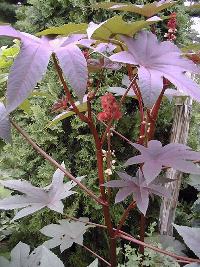Sunset®: All zones as an annual
USDA: All zones as an annual
Frost Tolerance: Perennial shrub in zone 9 and warmer
Heat Tolerance: Some afternoon shade is better in the low deserts
Sun Exposure: Full sun
Origin: Asia and Africa
Growth Habits: Tender evergreen perennial usually grown as a half-hardy annual, grows up to 6-12 feet tall (1.8-3.6 m), 6 feet wide in a season (1.8 m), as a tree, up to 25 feet tall (7.5 m); palmate leaves, up to 18 inches long and wide (45 cm)
Watering Needs: Regular water
Propagation: Seeds
Seeds can be deadly if ingested, the foliage can generate serious allergies.
The castor bean tree is used to generate rapidly a tropical effect.
Blooming Habits:
Male and female flowers are separate, both unimpressive. The female flowers are followed by a spiny red capsule, 0.5 to 1 inch in diameter (12-25 cm), containing 3 attractively colored mottled seeds.
Culture:
Soak the seeds in warm water overnight. Start the seeds indoor, 0.75 inch deep (2 cm), at 70 to 85°F (21 to 29°C). Plant 6-8 week old seedlings 3 feet apart. Seeds can also be sown in place. Depending on the location, the castor bean might self seed.
Desert-Tropicals is dedicated to provide gardening advice, gardening ideas, and information about flower of all kind for landscape and collections.We try to check carefully the identification of the plants on the illustrations as well as the other information from the page, but occasionally errors do occur. if you notice anything that needs to be changed please contact us.Thanks.
© 1998-2020 Philippe Faucon, All Rights Reserved.
